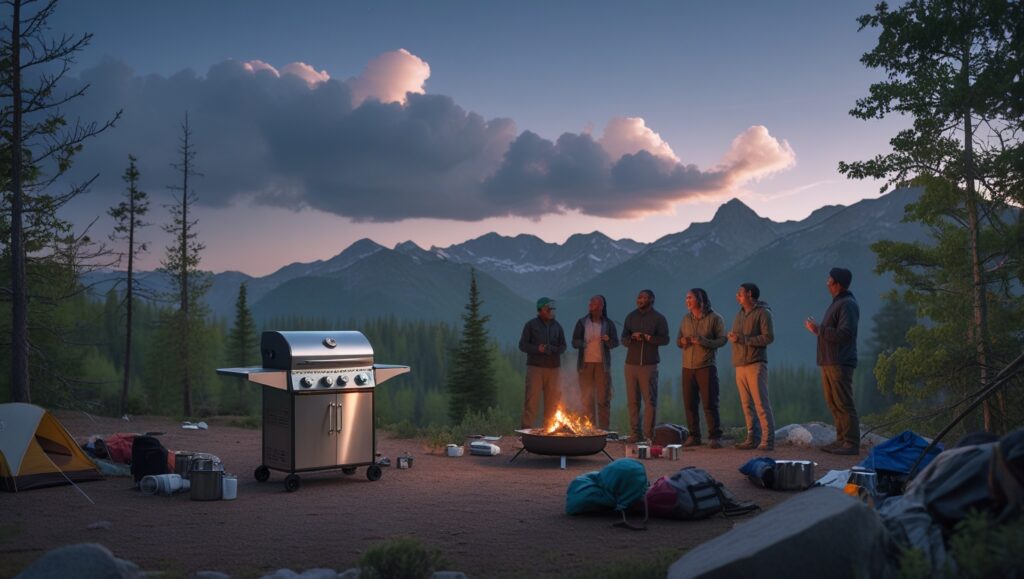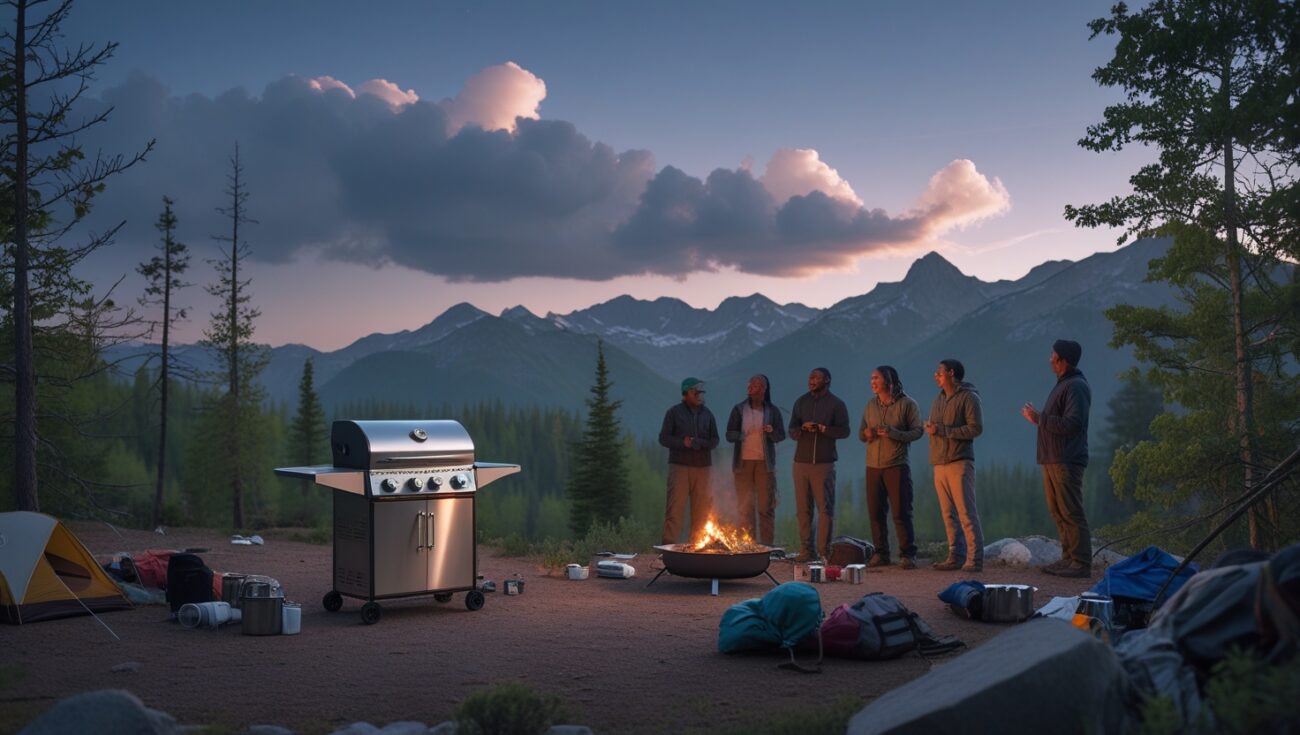Best Propane Grills for Cooking in High Altitudes While Camping
If you’ve ever tried to cook on a propane grill at high elevation—say 5,000 feet or more—you already know it’s a different game. At higher altitudes, the air is thinner, pressure is lower, and your grill doesn’t behave the same. Burners can be weaker, flames less stable, and cook times longer.
After several trips through the Rockies and Sierra Nevadas, I’ve learned the hard way what works—and what doesn’t. So in this post, I’m sharing the best propane grills on Amazon that perform reliably at high altitudes, along with tips for successful high-altitude cooking.

Table of Contents
Why Altitude Affects Your Propane Grill
At higher altitudes, the air contains less oxygen, which affects combustion. That means:
- Flames are weaker and more prone to blowing out
- Grills heat more slowly and unevenly
- You may need to adjust your burner usage and cooking times
- Regulator pressure matters more than you think
That’s why you want a grill with strong BTUs, good wind resistance, and an efficient burner design—plus a little patience.
Top Propane Grills That Perform Well in High Altitudes (Amazon Picks)
1. Camp Chef Explorer Double Burner Stove
With 30,000 BTUs per burner, this beast is made for the mountains. I’ve cooked at 9,000 feet using this grill without any issues. It handles wind well, and the burner power makes up for the loss of oxygen at elevation.
- Two powerful burners
- Modular system (griddle, grill box, pizza oven)
- Adjustable legs for uneven terrain
- Sturdy and dependable for long trips
2. Coleman RoadTrip 285 Stand-Up Grill
This one gets bonus points for its Swaptop cooktops and its wind-resistant lid. It has three burners with independent controls, which allows you to create hot zones even in thin air. I’ve used this above 7,500 feet, and it performed consistently.
- 20,000 BTUs
- 285 sq. in. cooking surface
- Works with 1 lb and 20 lb tanks
- Wheeled, collapsible design
3. Weber Q2200 Liquid Propane Grill
This grill is built like a tank. The cast aluminum body retains heat well, which is a major plus at elevation where heat escapes faster. It also features a powerful burner with a steady flame, even when the oxygen is low.
- 280 sq. in. cooking surface
- Electronic ignition
- Lid thermometer
- Compact but mighty performance
4. Blackstone 22-Inch Tabletop Griddle
Griddles like this one are great at high altitudes because they distribute heat evenly, helping counter the uneven heating that happens in thin air. I’ve cooked everything from eggs to burgers at 8,000 feet on this with no problem.
- 24,000 BTUs across two burners
- 330 sq. in. flat top cooking area
- Grease management system
- Works with both 1 lb and 20 lb tanks (adapter needed)
5. Flame King RV or Tabletop Grill
Compact, portable, and surprisingly powerful. This grill holds up well in wind, and its auto shut-off valve and pressure regulator make it safer and more reliable at elevation.
- 214 sq. in. cooking space
- Works as a tabletop or RV mount
- Built-in thermometer
- Ideal for campers staying above 6,000 feet
Tips for Using Propane Grills at High Altitudes
From personal experience, here’s what works best:
- Preheat longer: Let the grill warm up an extra 5–10 minutes
- Use wind protection: Even light breeze affects flames more up high
- Keep the lid closed more often to retain heat
- Cook in smaller batches to maintain consistent temperature
- Bring a propane tank with a high-pressure regulator for better flow
And always monitor the flame—a weak flame or frequent blowouts are common if your regulator isn’t dialed in.
Why These Grills Outperform Cheap Models Up High
Budget grills often struggle with elevation because they have:
- Lower BTU output
- Weak ignition systems
- Thin metal that loses heat quickly
- Poor regulator performance
That’s why I stick with brands like Camp Chef, Weber, Coleman, and Blackstone—they’re built with stronger burners and better materials to handle the challenge.
Best Accessories for High-Elevation Cooking
To help your grill work better in the mountains, I recommend:
- Wind guards or foil barriers
- A grill thermometer (built-in or separate)
- A 5 ft propane adapter hose to connect 20 lb tanks
- Heat-resistant gloves (temps fluctuate quickly at altitude)
- Cast iron cookware for better heat retention
Great for Rocky Mountain, Yosemite, and Alpine Trips
I’ve personally tested these grills at over 8,000 feet in places like Estes Park, Mammoth Lakes, and Grand Teton. They’ve held up to wind, cold mornings, and back-to-back cooking sessions with no issue. If you’re planning an alpine adventure, these are your best bets.
Power, Reliability, and Altitude-Ready Performance
High-altitude camping comes with challenges—but your cooking setup shouldn’t be one of them. With the right propane grill, you’ll be able to boil water, grill meat, and cook full meals without frustration.
If I had to choose just one? The Camp Chef Explorer is my top pick for its raw power and flexibility. But if you want something more portable, go for the Weber Q2200 or Coleman RoadTrip 285.
I’ve Burned More Meals at 7,000 Feet Than I’d Like to Admit
Cooking at high altitude caught me off guard the first time. My bacon didn’t crisp, my burgers stayed pink, and boiling water felt like it took forever. That’s when I realized: not all propane grills are built to perform in the mountains. Since then, I only bring models I know can handle the thin air.
Look for Grills with Solid Lids and Insulated Construction
At high elevations, heat escapes faster. That’s why I stick with grills that have heavy-duty lids and thick, insulated bodies. The Weber Q2200, for example, holds heat like a champ even when the outside temp drops. A good lid traps heat and keeps the temperature consistent—something you absolutely need in the mountains.
Wind Is a Bigger Problem Than You Think
Even light breezes can mess with burner output when you’re up high. The flame gets thinner and sometimes even blows out completely. That’s why I prefer models with low, wind-resistant burner placement or side panels. The Coleman RoadTrip and Camp Chef Explorer both hold their own in gusty conditions.
Boiling Water Takes Longer—So Plan Accordingly
Water boils at lower temperatures in high elevations. That means it not only takes longer, but also doesn’t get as hot as it does at sea level. If you’re boiling pasta, coffee, or soup on your propane grill, start early and use a lid to trap as much heat as possible. Flat-top griddles like Blackstone’s also help maintain steady heat distribution.
Use the Right Fuel Setup for Best Results
At higher altitudes, fuel pressure drops, especially with small 1 lb tanks. If you’re staying above 6,000 feet, I always recommend switching to a 20 lb propane tank with a proper regulator hose. This gives you more consistent flow, better burner performance, and less chance of flickering or weak flames.
Altitude Affects Food Texture, Too
It’s not just about grill heat—foods cook differently in the mountains. Meat may take longer to brown, and baked goods can flatten. I stick with thinner cuts of meat, foil-wrapped veggies, and food that doesn’t rely on long boiling. Having a propane grill that can deliver steady, strong heat gives you a major edge here.
Reliable Ignition Systems Matter More Up High
Weak spark igniters don’t always fire up at high altitudes. Cold mornings and thin air can make them glitchy. That’s why I prefer grills with push-button electronic ignition or matchless spark systems. The Camp Chef and Weber grills I’ve used in the mountains have fired up with no problem every time.
Don’t Rely on the Campfire Alone
Some national parks and campgrounds ban open fires due to dry conditions and wind risk. When that happens, your grill becomes your only source of hot meals. I always bring a propane grill that’s reliable, wind-resistant, and performs like a kitchen stove, even in the wild.
These Grills Also Work Great in Cold Weather
High altitude often means cold mornings and chilly evenings. The good news is that the same grills that perform at high elevations also excel in cold temps. The Blackstone griddle heats evenly across the surface, while the Weber Q2200 has excellent heat retention for cold-climate cooking.
Bring Backup: I Always Pack a Butane Stove, Too
While I trust my propane grills, I’ve learned that conditions in the mountains can change fast. I keep a Gas One butane/propane dual-fuel stove in my kit as a backup. It’s lightweight, compact, and perfect for boiling water quickly if my main grill is struggling or in use.
High-Altitude Breakfast is a Whole Vibe
There’s nothing like waking up in the mountains and frying eggs, pancakes, and bacon on a flat-top griddle with crisp morning air all around. The Blackstone tabletop griddle has become my go-to for breakfast above 7,000 feet—it’s fast, even, and easy to clean before hitting the trail.
Practice at Home Before Your Trip
Altitude changes everything. If you’ve never cooked at elevation before, test your grill at a nearby high-altitude spot or at least read your grill’s manual for high-altitude adjustments. Knowing how to preheat, adjust burners, and manage wind in advance makes your mountain trip smoother and your meals way more enjoyable.

